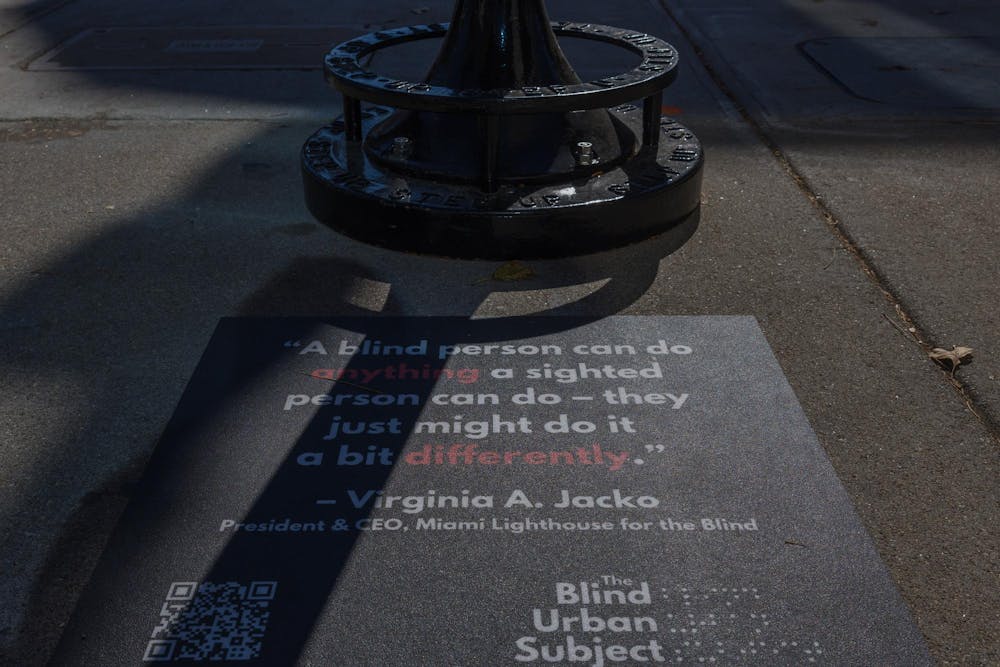Passersby on the northwest corner of Thayer and Angell Street might have noticed a new addition to their route: a binocular tower viewer. When peered into, the tower simulates the perspective of people with four visual conditions: glaucoma, cataracts, diabetic retinopathy and macular degeneration.
Officially launched on Friday, the art installation — dubbed “The Blind Urban Subject” and spearheaded by Daniel Solomon ’26 — is the work of a collective of Brown and RISD students with the support of both universities, multiple organizations and the City of Providence.
Born with ocular albinism, a genetic condition that affects vision and light sensitivity, Solomon said he was motivated by his own experiences as a legally blind individual. Through his activism within the blind community, he sought to increase urban accessibility and raise awareness about the ways in which visually impaired individuals engage with their environments.
“At its core, ‘The Blind Urban Subject’ offers passersby a vantage point to experience a familiar urban intersection — Thayer Street and Angell Street — from the perspective of someone who experiences life much differently than most,” Solomon wrote in an email to The Herald.
“Even if only in some small way, we hope that this installation helps people gain a more mutual understanding of the blind and visually impaired,” he added.
The event generated much buzz, attracting attendance from Brown administrators and Rhode Island elected officials. Following a short reception on the steps of the Lindemann Performing Arts Center, organizers introduced the art installation and recognized the many contributions that led to its creation.
Zoe Goldemberg ’27, a Brown-RISD Dual Degree student, served as the installation’s design engineering director. Goldemberg was part of the entire construction of the installation, from research and prototyping to the physical installation.
“I put together a team of RISD industrial designers who each had a specific role in terms of mechanical design, rapid prototyping and additive manufacturing,” Goldemberg wrote in an email to The Herald.
The design team, consisting of RISD students Gresh Chapman, Hudson Hale and Brown-RISD Dual Degree student Yutaka Tomokiyo ’27, worked alongside medical professionals to better understand different visual conditions and how they could be depicted through the binocular tower viewer.
Throughout the speeches, much of the conversation centered around an important theme: increasing accessibility for visually impaired individuals in Providence.
Rishika Kartik ’26, the installation’s community engagement and outreach director, has worked extensively with the blind community. Together with Solomon, she helped co-found Blind@Brown, an organization dedicated to advocating for blind, visually impaired and low-vision students.
“I hope visitors learn that blindness isn’t taboo, mysterious or something to be afraid of,” she wrote in an email to The Herald. “We hope people realize that the majority of blind people are also very engaged in urban life, and because of that, urban accessibility is all the more crucial. Ultimately, we hope that people are encouraged to consider accessibility more, as a friend, citizen, employee and member of the world.”
Providence Mayor Brett Smiley, one of the elected officials in attendance, emphasized the importance of urban accessibility.
“Accessibility in this city is very broadly defined, and we want to be inclusive,” he said. “We need empathy to ensure that we are building a city, an infrastructure, that works for all.”
Grace Pires, the president of Rhode Island’s National Federation of the Blind chapter, also spoke at the event, emphasizing the necessity of curiosity in cultivating inclusivity.
“It is incumbent on us, the blindness community, and our allies to raise awareness — not only of the barriers that we face, but also about the capacity of blind people,” Pires said.
In the presence of the many elected officials, Pires reminded attendees that in addition to being a groundbreaking art installation, The Blind Urban Subject also serves as a reminder of the work that still needs to be done to make urban cities more inclusive.
Following comments by speakers, Solomon led guests on a walk down Angell Street for the ribbon-cutting ceremony that would inaugurate the installation for the public. Lining the path down Angell and Thayer Street were decals that describe the types of blindness featured in the installation.
“I’ve been passing the art installation during my everyday walk, so I was really curious about it,” launch attendee Sofia Kassalow ’26 said. “I figured I would learn all about how it came to fruition and the story behind it.”
Patricia Poitevien, the interim vice president of the Office of Institutional Equity and Diversity, also attended the event.
“I’m thrilled that space is being created for students who have different abilities because they are a very important part of our community, and in particular, an important part of underrepresented populations,” she said.
“I think it’s a really hard thing to understand what it’s like to live with a visual impairment,” said Jack Morris ’25, a visually impaired student who attended the launch. “I hope people will just come take a look and try and get a sense of the unique physical perspective that we all have in navigating the world.”
For Solomon, the opening of The Blind Urban Subject is just the beginning.
“We want people to think new thoughts,” he said. “We want them to challenge their realities.”





